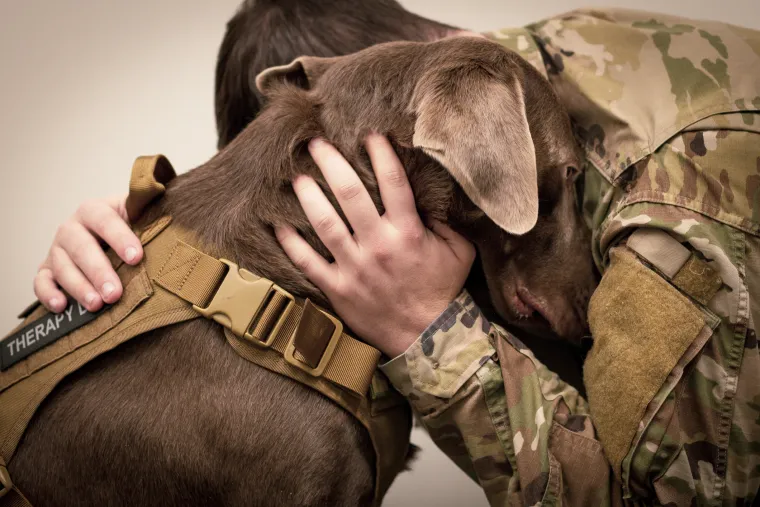Service DogS & PTSD
At the OHAIRE lab, we research to better understand the psychosocial outcomes of having a service dog for PTSD.
What is PTSD?
Post-traumatic Stress Disorder (PTSD) is trauma and stress-related disorder that affects 6.8% of individuals at some point in their lives [5]. PTSD can develop from exposure to various psychologically traumatic events, such as experiencing sexual abuse or assault, a life-threatening event or natural disaster, or unexpected death or harm to a loved one [1].
Our Research
The OHAIRE Group is collaborating with service dog providers K9s For Warriors and Canine Companions to evaluate the effects of service dogs on veterans with posttraumatic stress disorder (PTSD), traumatic brain injury (TBI), and/or military sexual trauma (MST) and their partners/spouses. Many anecdotal reports suggest that service dogs provide unique benefits to veterans with trauma. However, there is limited empirical research on this topic. Throughout multiple studies, this research stream has been funded by the National Institutes of Health (NICHD, NCCIH, NCATS), Mellon Foundation, Merrick Pet Care, the Human-Animal Bond Research Institute, Petco Foundation, Newman’s Own Foundation, Indiana Clinical, and Translational Sciences Institute, Bayer Animal Health, and Dogtopia Foundation. This research program aims to empirically evaluate the effects of service dogs on military members with trauma by comparing those with service dogs to those on the waitlist for a service dog. We are examining questions of efficacy (i.e., does it work?), mechanism (i.e., how does it work?), and usage (e.g., what trained tasks are used the most?). Our latest study aims to evaluate key clinical mental health and wellness indicators through standardized survey assessments and cortisol sampling. This study is a registered clinical trial. Our primary goal is to bring a scientific lens to better understand whether and how service dogs may assist veterans in need and their families.
PTSD and Military Personnel
Military personnel exposed to combat violence are at risk for developing PTSD. The recognition of the disorder by modern psychiatry in 1980 was primarily brought about due to the mental health experiences of veterans returning from the Korean and Vietnam Wars [2]. It is estimated that 23% of veterans deployed to Iraq and Afghanistan are impacted by PTSD [4].
PTSD is a complicated disorder to treat in military personnel. While empirically supported treatments work for many people, some can have significant dropout and nonresponse rates [3, 8]. Additionally, few treatments incorporate the family members and/or spouses, who often suffer from psychological distress, secondary trauma, and caregiver burden. Therefore, it is imperative to discover and, most importantly, to evaluate complementary and integrative treatments for PTSD that encourage retention and have family-wide effects.

What can service dogs do for PTSD?
Specially trained PTSD service dogs are one emerging complementary treatment option for PTSD that may address the family unit's needs and encourage treatment retention. PTSD service dogs are specifically trained to instill a sense of confidence, safety, and independence daily for the veteran. For example, a PTSD service dog may be trained to assist the veteran by "watching" their back in public, serving as a physical barrier between the veteran and approaching strangers, waking them up from nightmares, and serving as a brace for balance. However, not all dogs are trained to use the same cues, and specific cues may vary individually. Service dogs for PTSD are mostly Labrador Retrievers, Golden Retrievers, or German Shepherds but can be various breeds, including mixed breeds and rescue animals from shelters.
How Should I Interact with Someone with a PTSD Service Dog or Emotional Support Dog?
Because PTSD is an invisible disorder like diabetes or hearing loss, seeing an individual with a service or emotional support dog who seems perfectly healthy on the outside might be confusing in public. For military veterans suffering from PTSD, it is often very hurtful and personal to be asked what the dog "does" for them. To respect the privacy of the handler, it is poor etiquette to ask personal questions about their disability.
If you see a service dog or emotional support dog working in public, be respectful and do not approach or pet the dog without permission. Many veterans with a service dog are willing to answer respectful questions about their dogs, but you should not assume this is always the case. Those with a service or emotional support dog out in public are just going about their business like anyone else and might be too busy or unwilling to engage with everyone who approaches.
For service dogs only, the ADA states that employees of public areas may ask only two specific questions to a service dog handler:
- "Is the dog a service animal required because of a disability?"
- "What work or task has the dog been trained to perform?"
Staff are not allowed to ask for any documentation, ask for the service dog to demonstrate any tasks that they are trained to do, or ask about the handler's specific disability.

Current Research on Military Veterans & Service Dogs
Qualitative interviews and reports from veterans placed with PTSD service dogs suggest that service dogs can help with daily anxious arousal, hypervigilance (always being on alert), nightmares, flashbacks, and many of the struggles that those with PTSD face on a day-to-day basis [7, 9, 10]. In addition, veterans with a PTSD service dog report feeling more safe and secure in public, allowing them to do things like go to the movies with their family or the grocery store. These reports are anecdotal, meaning they do not apply to all veterans and include only a select number of cases.
Additionally, most of what we know regarding the relationship with and benefits received from owning a PTSD service dog or emotional support dog are from studies that are relatively weak with no control comparison (such as comparing to a waitlist group or a similar population of individuals who don't own a dog). Our research group at the Center for the Human Animal Bond has conducted a systematic review of the literature and found a lack of peer-reviewed, empirical studies of service dogs as a complementary treatment option for military veterans with PTSD [6].
There is a strong need for more research to determine the therapeutic effect dogs may have on the mental health and well-being of those with PTSD, particularly in the military. The Veteran's Administration (VA) does not currently provide any resources or funding for PTSD service dogs because of the lack of empirical evidence supporting their efficacy as a complementary treatment for PTSD.
- American Psychiatric Association. (2013). Diagnostic and statistical manual of mental disorders (5th ed.).
- Trimble, M. R. (1985). Post-traumatic stress disorder: History of a concept. In C.R.Figley (Ed.), Trauma and its wake: The study and treatment of post-traumatic stress disorder (pp. 5-14). New York: Brunner/Mazel .
- Foa, E. B., Cohen, J. A., Friedman, M. J., & Keane, T. M. (2008). Effective treatments for PTSD: Practice guidelines from the International Society for Traumatic Stress Studies. Guilford Publications.
- Fulton, J. J., Calhoun, P. S., Wagner, H. R., Schry, A. R., Hair, L. P., Feeling, N., Elbogen, E., & Beckham, J. C. (2015). The prevalence of posttraumatic stress disorder in Operation Enduring Freedom/Operation Iraqi Freedom (OEF/OIF) Veterans: A meta-analysis. Journal of Anxiety Disorders, 31, 98–107.
- Kessler, R. C., Berglund, P., Demler, O., Jin, R., Merikangas, K. R., & Walters, E. E. (2005). Lifetime prevalence and age-of-onset distributions of DSM-IV disorders in the National Comorbidity Survey Replication. Archives of General Psychiatry, 62(6), 593–602.
- O’Haire, M. E., Guérin, N. A., & Kirkham, A. C. (2015). Animal-assisted intervention for trauma: A systematic literature review. Frontiers in Psychology, 6.
- O’Haire, M. E., & Rodriguez, K. E. (2018). Preliminary efficacy of service dogs as a complementary treatment for posttraumatic stress disorder in military members and veterans. Journal of Consulting and Clinical Psychology, 86(2), 179–188.
- Steenkamp, M. M., Litz, B. T., Hoge, C. W., & Marmar, C. R. (2015). Psychotherapy for military-related PTSD: A review of randomized clinical trials. JAMA, 314(5), 489–500.
- Vincent, C., Dumont, F., Gagnon, D., Belleville, G., Auger, E., Lavoie, V., Besemann, M., Champagne, N., Bourassa, J., & Bernier-Banville, E. (2019). Psychiatric service dog outcomes for veterans with posttraumatic stress disorder over an 18 month-period: A pilot study. Journal of Neurology and Psychiatric Disorders, 2(1), 1–12.
- Yarborough, B. J. H., Owen-Smith, A. A., Stumbo, S. P., Yarborough, M. T., Perrin, N. A., & Green, C. A. (2017). An observational study of service dogs for veterans with posttraumatic stress disorder. Psychiatric Services (Washington, D.C.), 68(7), 730–734.
